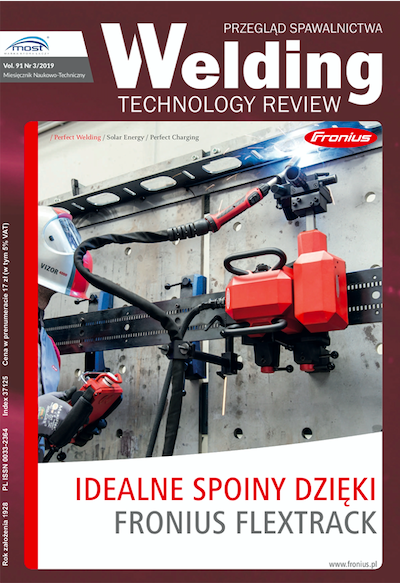Influence of machining parameters on surface texture of Inconel 718 after grinding with multi-granular wheels
##plugins.themes.bootstrap3.article.main##
Abstrakt
Requirements currently imposed on machine elements are constantly growing. It requires to develop new, advanced machining processes. One of the commonly used finishing process is grinding. The article presents the results of the exploratory research in the process of surface grinding with abrasive multigrain wheels of samples made of Inconel 718. The influence of input parameters was investigated: cutting speed Vc, transverse feed speed Fp, longitudinal feed speed Fw, on roughness parameters (Sa) and the bearing capacity curve. Based on the conducted research, statistical models of the grinding process were elaborated, which allow to select the most favorable processing parameters depending on the required quality of the surface texture.
Pobrania
##plugins.themes.bootstrap3.article.details##
Creative Commons CC BY 4.0 https://creativecommons.org/licenses/by/4.0/
Artykuły czasopisma Welding Technology Review (Przegląd Spawalnictwa) publikowane są w otwartym dostępie na licencji CC BY (licencja Creative Commons Uznanie autorstwa 4.0 Międzynarodowe). Licencja CC BY jest najbardziej otwartą dostępną licencją i uważaną za „złoty standard” w formule otwartego dostępu; jest również preferowany przez wielu fundatorów badań. Licencja ta umożliwia czytelnikom kopiowanie i redystrybucję materiału na dowolnym nośniku i w dowolnym formacie, a także zmienianie, przekształcanie lub budowanie na nim materiału, w tym do użytku komercyjnego, pod warunkiem wskazania oryginalnego autora.
Bibliografia
Abidi M.H., Al-Ahmari A.M., Siddiquee, A.N., Mian S.H., Mohammed M.K., Rasheed M.S., An Investigation of the Micro-Electrical Discharge Machining of Nickel-Titanium Shape Memory Alloy Using Grey Relations Coupled with Principal Component Analysis, Metals, 2017, Vol. 7, 486. DOI: https://doi.org/10.3390/met7110486
Świercz R., Oniszczuk-Świercz D., Dabrowski L., Electrical discharge machining of difficult to cut materials, Archive of Mechanical Engineering, 2018, Vol. 65, 461476.
Nowicki R., Świercz R., Oniszczuk-Świercz D., Dąbrowski L., Kopytowski A., Influence of machining parameters on surface texture and material removal rate of Inconel 718 after electrical discharge machining assisted with ultrasonic vibration, AIP Conference Proceedings, 2018, 020019. DOI: https://doi.org/10.1063/1.5056282
Świercz R., Oniszczuk-Świercz D., Chmielewski T., Multi-Response Optimization of Electrical Discharge Machining Using the Desirability Function, Micromachines, 2019, Vol. 10, 72. DOI: https://doi.org/10.3390/mi10010072
Klocke F., Zeis M., Klink A., Interdisciplinary modelling of the electrochemical machining process for engine blades, CIRP Annals, 2015, Vol. 64, 217220. DOI: https://doi.org/10.1016/j.cirp.2015.04.071
Ruszaj A., Gawlik J., Skoczypiec S., Electrochemical Machining Special Equipment and Applications in Aircraft Industry, Management and Production Engineering Review, 2016, Vol. 7, 3441. DOI: https://doi.org/10.1515/mper-2016-0015
Skoczypiec S., Ruszaj A., A sequential electrochemicalelectrodischarge process for micropart manufacturing, Precision Engineering, 2014, Vol. 38, 680690. DOI: https://doi.org/10.1016/j.precisioneng.2014.03.007
Gołąbczak M., Święcik R., Gołąbczak A., Nouveau C., Jacquet P., Blanc C., Investigations of surface layer temperature and morphology of hard machinable materials used in aircraft industry during abrasive electrodischarge grinding process, Materialwissenschaft und Werkstofftechnik, 2018, Vol. 49, 568576. DOI: https://doi.org/10.1002/mawe.201700249
Spadło S., Depczyński W., Młynarczyk P., Selected properties of high velocity oxy liquid fuel (HVOLF) - sprayed nanocrystalline WC-CO INFRALLOYTM S7412 coatings modified by high energy electric pulse, Metalurgija, 2017, Vol. 56, 412414.
Salacinski T., Winiarski M., Chmielewski T., Świercz R., Surface finishing using ceramic fibre brush tools, Proceedings of the 26th International Conference on Metallurgy and Materials, 2017, 12201226.
Oniszczuk-Świercz D., Świercz R., Nowicki R., Kopytowski A., Dąbrowski L., Investigation of the influence of process parameters of wire electrical discharge machining using coated brass on the surface roughness of Inconel 718. AIP Conference Proceedings 2018, 2017, 020020. DOI: https://doi.org/10.1063/1.5056283
Chmielewski T., Szulc J., Pilat Z., Badania metalograficzne spoin wykonanych hybrydową metodą PTA-MAG, Welding Technology Review, 2014, Vol. 86(7), 46-48. DOI: https://doi.org/10.26628/ps.v86i7.64
Mat J., Study on the grinding of Inconel 718. Proc. Technol 55 1995. DOI: https://doi.org/10.1016/0924-0136(95)02026-8
Żółkoś M., Gdula M., Wpływ wprowadzenia drgań ultradźwiękowych do procesu szlifowania stopu inconel 718, Mechanik, Vol. 89 3/17, 385-392. DOI: https://doi.org/10.7862/rm.2017.35
Groover M.P., Fundamentals of modern manufacturing: materials, processes and systems. 4th edition, ISBN 978-0470-467002, 2010.
Sikora M., Lajmert P., Ostrowski D., Kruszyński T., Szlifowanie stopów niklu na szlifierce kłowej do wałków. Mechanik, 9/2014, 289-291.
Rosik R., Wójcik R., Gradulska A., Wpływ rodzaju ziarna ściernego nowej generacji na chropowatość powierzchni Inconelu 718, Mechanik, 8-9/2015, 285-286.
